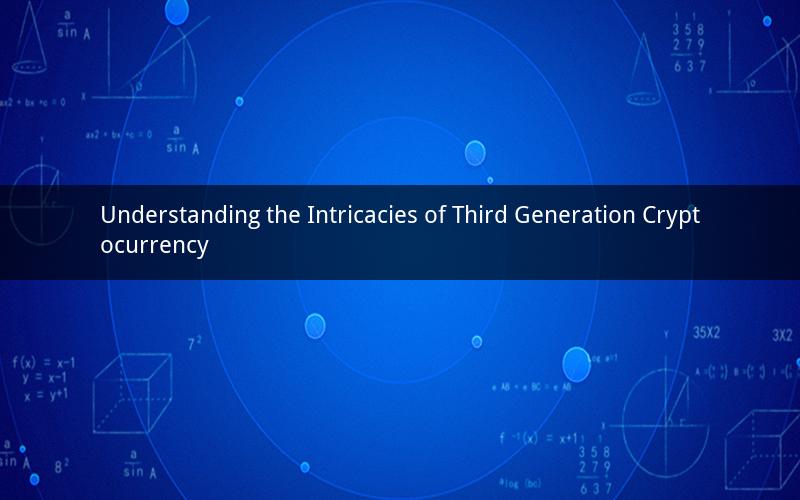
Introduction:
In the rapidly evolving world of cryptocurrency, the term "third generation cryptocurrency" has become increasingly popular. But what exactly is third generation cryptocurrency? How does it differ from its predecessors, and what makes it stand out in the bustling crypto landscape? This article delves into the world of third generation cryptocurrency, exploring its characteristics, advantages, and the future it holds for the crypto community.
Section 1: What is Third Generation Cryptocurrency?
1. Definition
Third generation cryptocurrency refers to the latest iteration of digital currencies, characterized by enhanced features and improved functionality compared to their predecessors, the first and second generations. These cryptocurrencies aim to address the limitations and challenges faced by the earlier generations, such as scalability, privacy, and decentralization.
2. Evolution
The evolution of cryptocurrency can be categorized into three generations:
a. First Generation: Bitcoin (BTC)
Bitcoin, launched in 2009, marked the beginning of the cryptocurrency revolution. It introduced the concept of blockchain technology, decentralized ledger, and digital money. However, Bitcoin has limitations, such as slow transaction speed and high transaction fees.
b. Second Generation: Ethereum (ETH)
Ethereum, launched in 2015, brought smart contracts and decentralized applications (DApps) to the forefront. It addressed the scalability issue faced by Bitcoin but still had its own limitations, such as the potential for smart contract vulnerabilities.
c. Third Generation: Cardano (ADA), Tezos (XTZ), Polkadot (DOT), etc.
Third generation cryptocurrencies are designed to overcome the limitations of the first and second generations. They focus on improving scalability, privacy, and sustainability, while also incorporating advanced technologies like proof-of-stake, sharding, and cross-chain interoperability.
Section 2: Key Features of Third Generation Cryptocurrency
1. Scalability
Scalability is a crucial factor in third generation cryptocurrency. To accommodate a growing number of users and transactions, these cryptocurrencies utilize advanced technologies like sharding and proof-of-stake. Sharding divides the network into smaller segments, allowing for faster and more efficient processing of transactions.
2. Privacy
Third generation cryptocurrencies prioritize privacy by implementing advanced privacy features like zero-knowledge proofs and ring signatures. These features ensure that users' transaction details remain confidential, protecting their privacy from potential third-party surveillance.
3. Sustainability
Sustainability is a significant concern for third generation cryptocurrencies. Many of these digital assets employ proof-of-stake (PoS) consensus mechanisms, which consume significantly less energy compared to proof-of-work (PoW) mechanisms. This shift towards PoS contributes to a more eco-friendly and sustainable crypto ecosystem.
4. Cross-Chain Interoperability
Cross-chain interoperability refers to the ability of different blockchain networks to communicate and exchange information with each other. Third generation cryptocurrencies focus on building a more interconnected and cohesive crypto ecosystem, facilitating seamless transactions and DApp development across multiple blockchains.
Section 3: The Future of Third Generation Cryptocurrency
The future of third generation cryptocurrency looks promising. As these digital assets continue to evolve and improve, they are likely to become the backbone of the crypto industry. Here are a few potential developments:
1. Adoption of Third Generation Cryptocurrencies
As more individuals and institutions recognize the benefits of third generation cryptocurrencies, their adoption is expected to grow. This increased adoption will likely drive the demand for these digital assets, leading to higher prices and a more robust crypto market.
2. Integration with Real-World Applications
Third generation cryptocurrencies are well-suited for real-world applications, such as cross-border payments, supply chain management, and smart contracts. As more businesses and industries adopt these digital assets, the potential for innovation and growth is immense.
3. Collaboration between Blockchain Projects
Collaboration between different blockchain projects will play a crucial role in the development of third generation cryptocurrencies. By sharing knowledge, resources, and technology, these projects can work together to create a more robust and scalable crypto ecosystem.
4. Regulatory Frameworks
As third generation cryptocurrencies gain more attention, governments and regulatory bodies are likely to develop frameworks to regulate the crypto industry. This will help to ensure the stability and security of the crypto ecosystem while mitigating potential risks.
Section 4: Conclusion
Third generation cryptocurrency represents the latest iteration of digital assets, offering improved functionality, scalability, and sustainability compared to their predecessors. As the crypto industry continues to evolve, third generation cryptocurrencies are poised to become the driving force behind the future of digital finance.
FAQs:
1. What is the difference between first, second, and third generation cryptocurrency?
First generation cryptocurrencies, like Bitcoin, introduced the concept of digital money. Second generation cryptocurrencies, such as Ethereum, focused on smart contracts and DApps. Third generation cryptocurrencies, like Cardano and Polkadot, aim to improve scalability, privacy, and sustainability.
2. Why are third generation cryptocurrencies more energy-efficient?
Third generation cryptocurrencies use proof-of-stake (PoS) consensus mechanisms, which consume significantly less energy compared to proof-of-work (PoW) mechanisms used by Bitcoin and other first and second generation cryptocurrencies.
3. Can third generation cryptocurrencies replace fiat currencies?
While third generation cryptocurrencies have the potential to disrupt traditional finance, it is unlikely that they will completely replace fiat currencies. Instead, they are expected to coexist with fiat currencies, providing new opportunities for financial innovation and inclusion.
4. Are third generation cryptocurrencies more secure than their predecessors?
Third generation cryptocurrencies offer enhanced security features, such as zero-knowledge proofs and ring signatures. However, no cryptocurrency is entirely immune to security risks. It is crucial for users to stay informed and take appropriate measures to protect their digital assets.
5. What is the role of cross-chain interoperability in third generation cryptocurrency?
Cross-chain interoperability allows different blockchain networks to communicate and exchange information. This feature facilitates seamless transactions and DApp development across multiple blockchains, contributing to a more interconnected and cohesive crypto ecosystem.